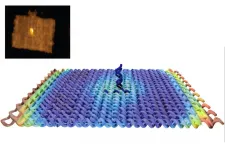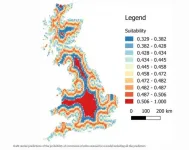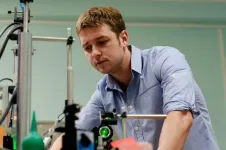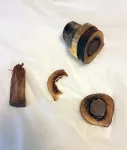Origami with DNA
A team at TU Wien was able to answer important questions about the immune system - with a trick reminiscent of paper folding.
2021-02-01
(Press-News.org) T-cells are an important component of our immune system: with the receptors they carry on their surface, they can recognise highly specific antigens. Upon detection of an intruder, an immune response is triggered. It is still unclear exactly what happens when antigens are recognised: How many antigens are necessary to elicit an immune response, and does the response depend on their spatial arrangement?
These effects take place in the nanometer range - on the size scale of molecules, far below what can be seen with ordinary microscopes. To study all this, tiny tools are needed. Therefore, an unusual method was used at TU Wien: DNA molecules were folded in an ingenious way, similar to the paper folding art origami. In this way, not just a double helix is created, but a rectangular "molecular raft" that floats across a cell membrane and serves as a tool for novel measurements. The results have now been published in the scientific journal PNAS.
Artificial cell membranes
"T cells react to antigens presented by specific cells on their surface. To be able to study this interaction between the T-cells and the antigen-presenting cells in detail, we replace the antigen-presenting cell with an artificial cell membrane. This allows us to control the number and type of antigens ourselves," says Prof. Eva Sevcsik, biophysicist at the Institute of Applied Physics at TU Wien.
"There was some evidence that the spatial distance between antigens plays an important role in T-cell activation," says Joschka Hellmeier, who did research on this project as part of his dissertation. "However, it is difficult to study these effects precisely: The distance between the individual antigens is not so easy to determine."
The cell membrane is not a fixed structure where every molecule stays in place. The antigens in the cell membrane can move freely, much like inflatable plastic toys floating on a water surface. "Therefore, we wanted to establish a method to precisely set certain distances between antigens and then study the reaction of the T-cells," Eva Sevcsik explains.
DNA origami
To do this, the researchers made use of an important natural phenomenon: DNA, the carrier of genetic information in our body, consists of two precisely matching single strands that join together without external intervention to form a DNA double helix.
This property is exploited in DNA nanotechnology: "By cleverly designing single strands that only fit together in certain sections, you can connect several double helices with each other and thus create complicated structures," explains Eva Sevcsik. "This technique is called DNA origami - instead of folding paper, we fold DNA strands."
In this way, the research team built rectangular DNA platforms to which one can fix an antigen. This DNA rectangle is placed on the artificial membrane and it moves there like a raft.
"This way we can guarantee that the antigens do not come arbitrarily close to each other," says Joschka Hellmeier. "Even if two of these DNA rafts move close together, there is still a minimum distance between the antigens if only one antigen is fixed on each DNA raft." In addition, it is possible to built DNA raft variants each carrying two antigens at the same time. That way it is possible to study how the T-cells react to different antigen spacing.
Old riddle solved
Using this strategy, they were able to explain the contradictory observations that had caused confusion in the field of molecular immunology in recent years: sometimes, several neighbouring antigens seemed to be necessary to activate T-cells, in other cases, a single one was sufficient. "With the help of our DNA origami technique, we were able to clarify the role of molecular distances for T-cell activation," says Eva Sevcsik.
For naturally occurring antigens, the distance does not matter - they act "solo" and are thus very efficient in T-cell activation. In research, however, instead of antigens, artificial T-cell activators are often used that bind particularly strongly to the T-cell receptor - and in this case at least two neighbouring molecules are needed to activate the T-cell. "This is an important result," says Eva Sevcsik. "We were able to show for the first time that there are two different mechanisms here, this will play an important role for future studies and the development of T-cell-based immunotherapies used to treat cancer."
INFORMATION:
Contact
Prof. Eva Sevcsik
Institute for Applied Physics
TU Wien
+43 1 58801 134898
eva.sevcsik@tuwien.ac.at
[Attachments] See images for this press release:

ELSE PRESS RELEASES FROM THIS DATE:
2021-02-01
Students from lower socio-economic groups (SEG) are less likely to participate in sport or physical activity at university, research from Sheffield Hallam University has found.
The main barriers affecting participation were found to be down to cost of being part of a sports team, lack of time due to academic commitments, part-time working or their social life taking precedence and limited prior knowledge of and participation in sport before starting university.
Funded by British Universities and Colleges Sport and published in the peer-reviewed Sport, Education and Society journal, the study surveyed over 700 students from 20 universities and found those that had participated in sport and physical ...
2021-02-01
A collaboration between the Pericàs group with Prof. Timothy Noël and Dr. Paola Riente at the Eindhoven University of Technology (TU/e, The Netherlands), has crystallised in a Nature Communications paper where they provide key insight into the chemical nature of the true photocatalyst involved in the Bi2O3-driven atom-transfer radical addition (ATRA) reaction.
Back in 2014, ICREA professors Miquel Pericàs and Emilio Palomares together with former postdoctoral researcher Dr. Riente published a paper on Angewandte Chemie International Edition pioneering the research on organic transformations in mild reactions conditions ...
2021-02-01
The work of the research group under the guidance of Professor Leonid Martyushev (co-authors: Roman Bando and Evgenia Chervontseva) will help to predict the behavior of fluids in various environments.
"When oil wells are depleted, water is pumped there under pressure to force the residual oil to the surface. If the interface between water and oil were an even layer, then it would be safe to say that as a result of water injection we recover all the residual oil. But since the interface between the two liquids is a highly distorted section, oil, contrary to expectations, can still remain underground, while water comes out to the surface. This is where our calculations come in ...
2021-02-01
The coronavirus crisis has led to some of the general public developing a critical view of the current food consumption model, as shown by a recent survey by the Catalan Consumer Agency, which reveals that 60.5% of all Catalans tend to think that the pandemic will promote more responsible, sustainable and fair consumption. Moreover, the various lockdowns have caused a significant increase in online shopping throughout Spain, with a 92% rise in volume and a 114.5% rise in value, according to aggregated consumption data from the Ministry of Agriculture, Fisheries and Food. This change in shopping habits and the awareness of the food model may also ...
2021-02-01
The human body strives to keep itself in homeostasis, or balance. When blood clots are created, the body's innate response is to break the clots down to prevent significant health problems from arising.
Research has found that patients with COVID-19 are prone to serious blood clotting. This is why many patients receive high dose anticoagulants as part of their treatment.
But a new study in Scientific Reports, led by senior author Daniel Lawrence, Ph.D., a Professor of Basic Research in Cardiovascular Medicine at Michigan Medicine, found that aside ...
2021-02-01
New research by Swansea University scientists found that boat ramps facilitate the dispersal of the highly invasive zebra mussel (Dreissena polymorpha).
To contain the dispersion of this invasive species Dr Marta Rodriguez-Rey and co-authors suggest in the new study, that strict control measures and target monitoring around boat ramps should be implemented.
Invasive bivalves are a problem as they can cause widespread environmental damage, and eradication has proved difficult. The zebra mussel is one of the most damaging invasive bivalves - it reproduces fast, disperses widely, and damages the economy. In Great Britain, £5 million are lost each year due to pipe fouling and damage to water infrastructures caused ...
2021-02-01
Titanium dioxide nanoparticles decorated by gold absorb about 96% of the solar spectrum and turn it into heat. The material can accelerate the evaporation in desalination plants up to 2.5 times and can track hazardous molecules and compounds. An international research team with representatives from Far Eastern Federal University (FEFU), ITMO University, and the Far Eastern Branch of the Russian Academy of Sciences, published a related article in ACS Applied Materials and Interfaces.
Access to safe water is included in the 17 UN Sustainable Development Goals. Meanwhile, the World Health Organization (WHO), and the Children's Fund (UNICEF) addressed the problem in 2019 report, noting that 2.2 ...
2021-02-01
In Rome lies the Santi Apostoli church, cared for by Franciscan brothers for more than 500 years. For more than 1500 years, this site has held the believed remains of two of the earliest Christians and Jesu apostles: St. Philip and St. James the Younger - relics of the Holy Catholic Church.
In the first few centuries of Christianity, life was difficult for the Christian minority, but gradually towards sixth century Christianity became the dominant religion and after Emperor Constantine on his deathbed declared Christianity the state religion, churches were erected all over the Roman Empire.
Shortly after the churches were erected, remains of worshipped Christian martyrs were moved from their ...
2021-02-01
The application Radar COVID detects twice as many close contacts of people infected with the virus SARS-Cov2 as the manual tracing system. This is the conclusion of the first scientific study that was carried out to assess the application in a trial carried out last summer on the island of La Gomera in the Canary Islands. The following researchers were involved in the project; Àlex Arenas, professor from the Department of Computer Engineering and Mathematics; Lucas Lacasa, from the Queen Mary University, London; and Pablo Rodríguez, from the Association of Computing Machinery, United States. The results have been published in the scientific journal Nature Communications.
The aim of the study was to check the technical and ...
2021-02-01
An atlas of harmful algal blooms across the Red Sea reveals their link with industrial aquaculture and how these blooms have changed in recent decades.
Warming oceans and anthropogenic pollution have led to more frequent and extensive harmful algal blooms (HABs) worldwide. These rapid surges in productivity occur when algae suddenly experience advantageous conditions, usually an influx of nutrients, and take over their environment, suffocating other marine life and spreading toxins through the food chain. These blooms harm wild and farmed fish and reduce marine biodiversity.
"HABs are a global problem," says ...
LAST 30 PRESS RELEASES:
[Press-News.org] Origami with DNA
A team at TU Wien was able to answer important questions about the immune system - with a trick reminiscent of paper folding.





